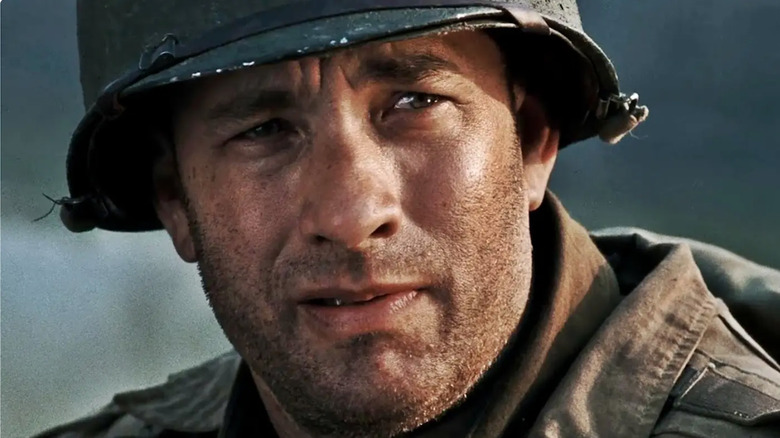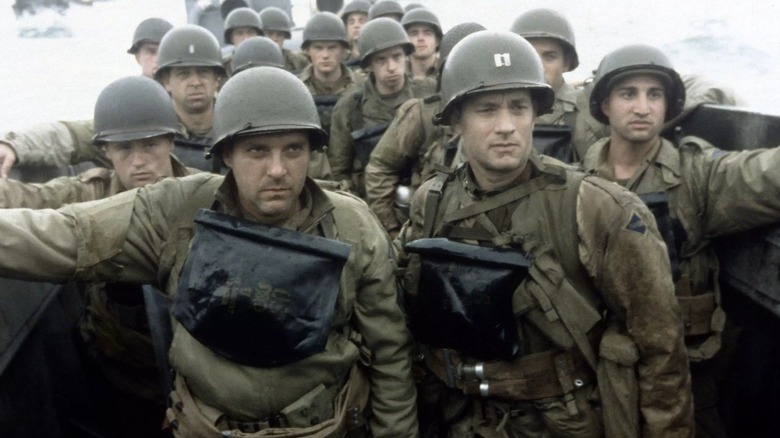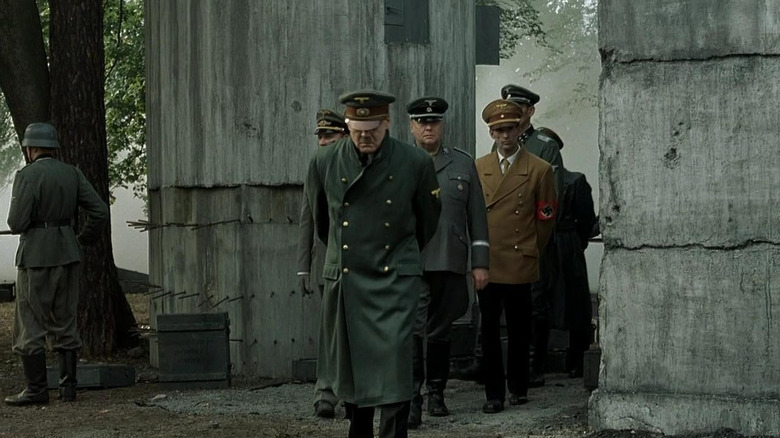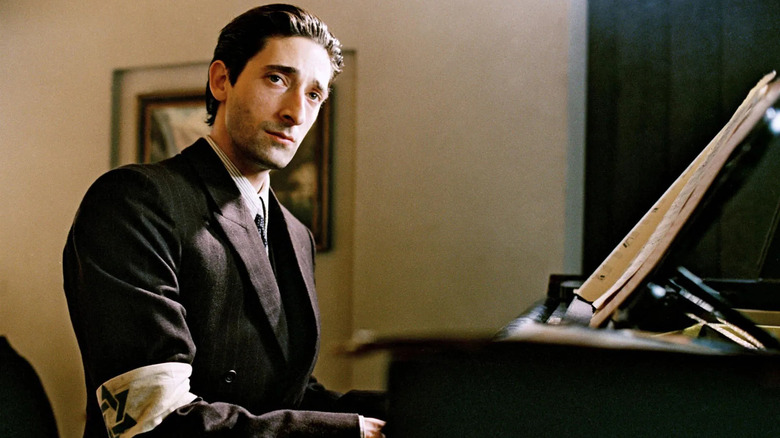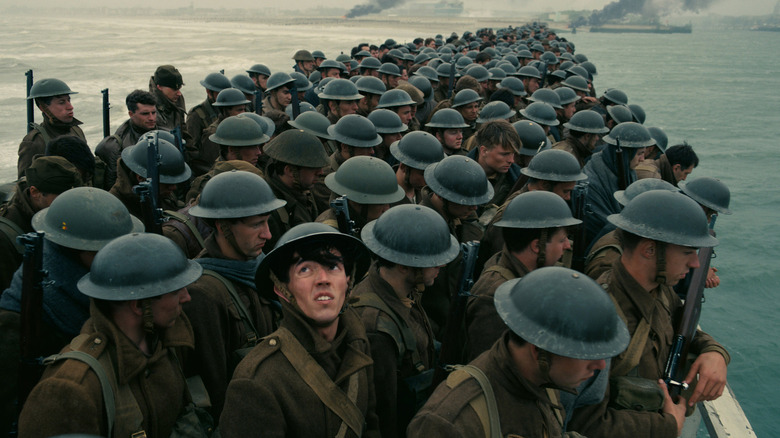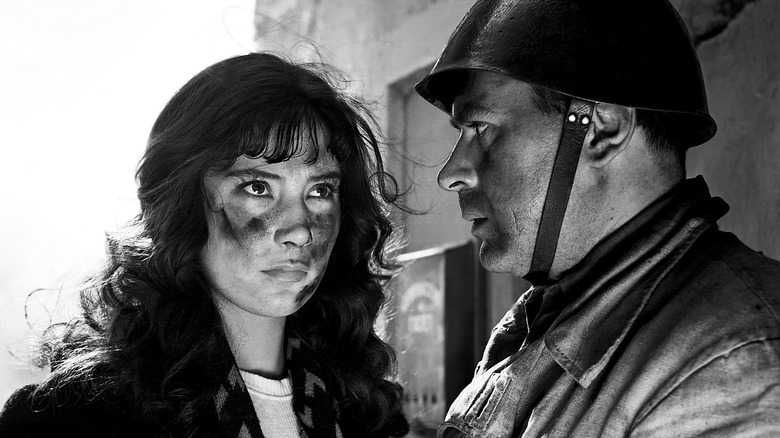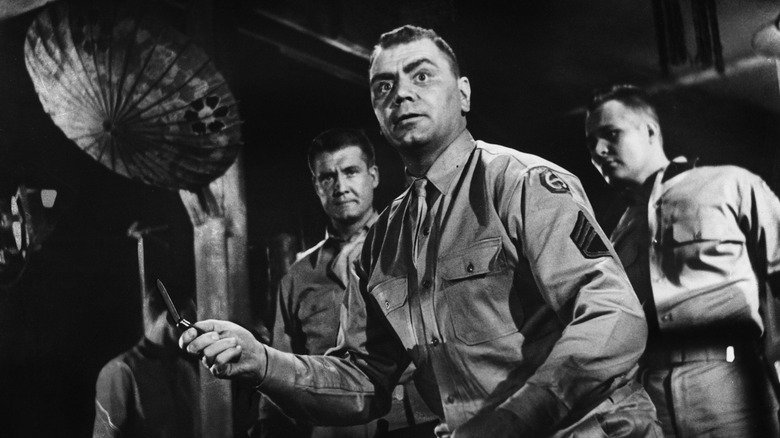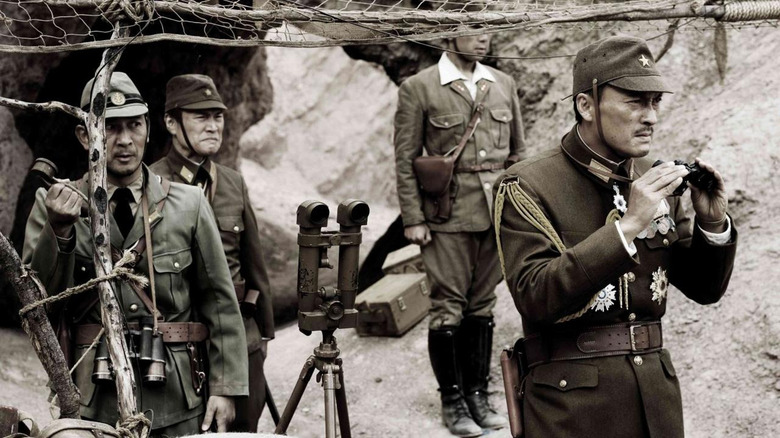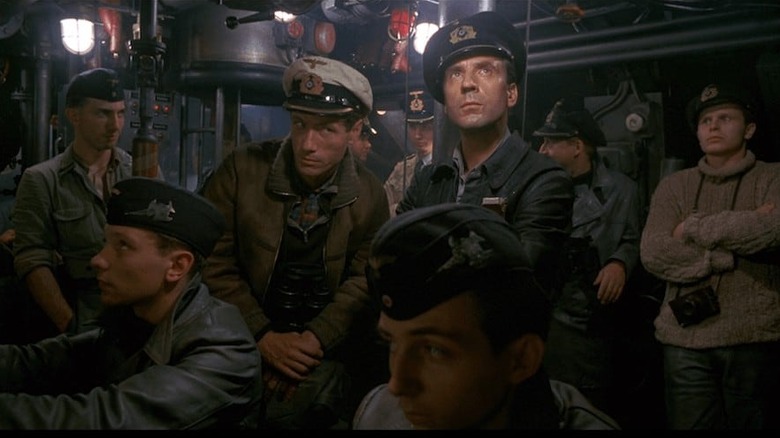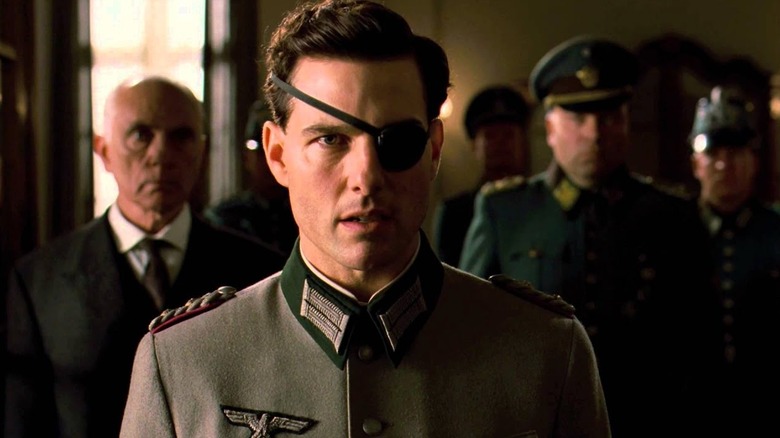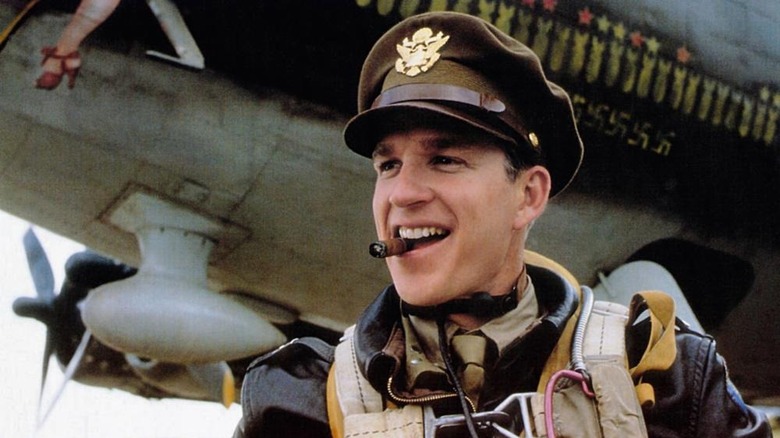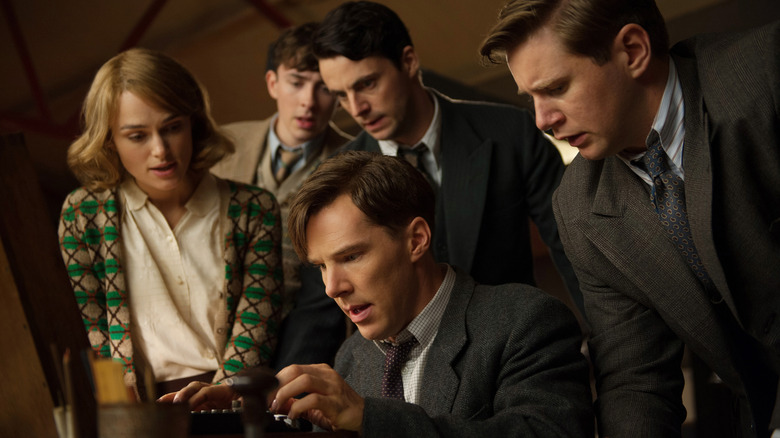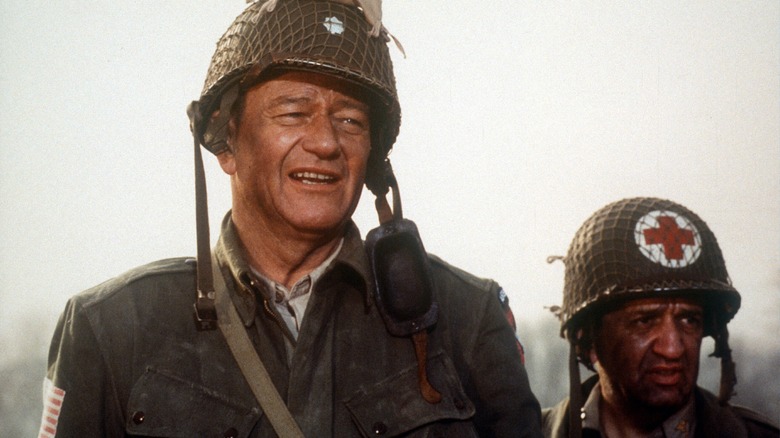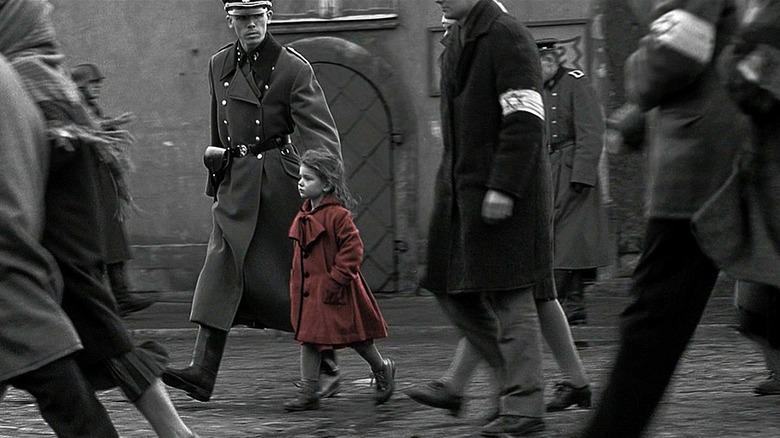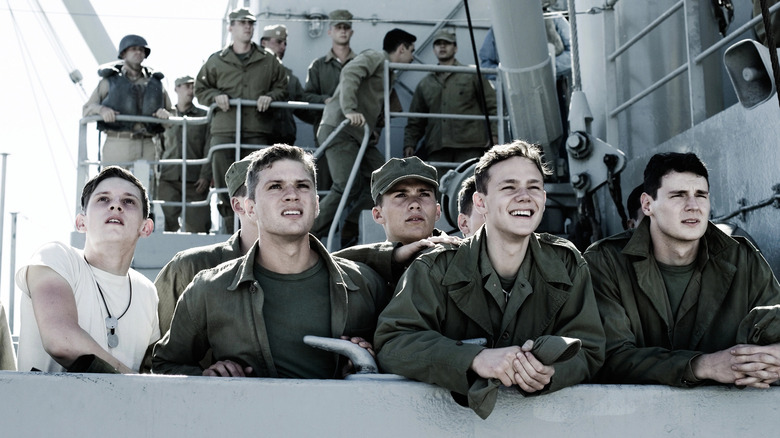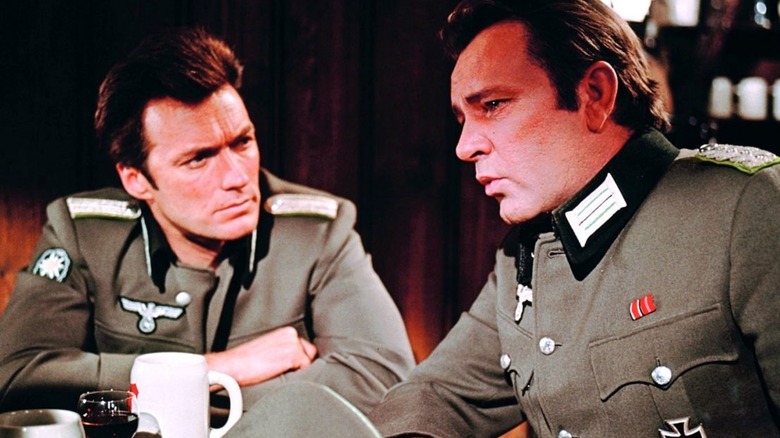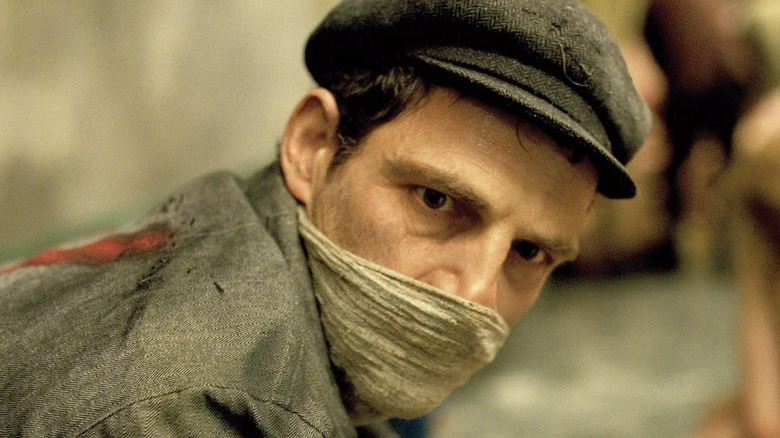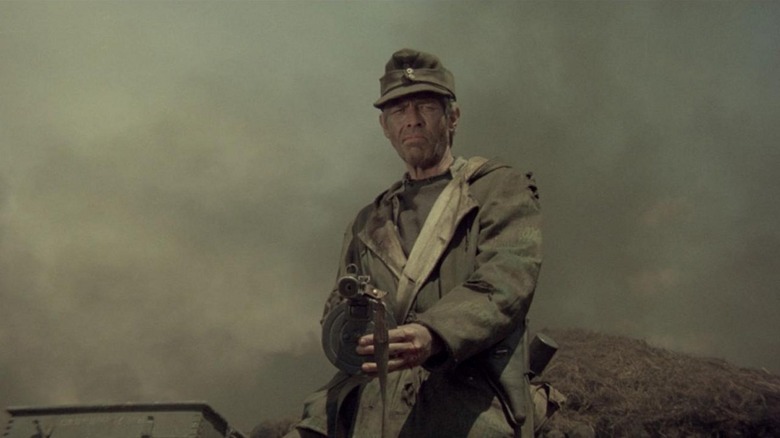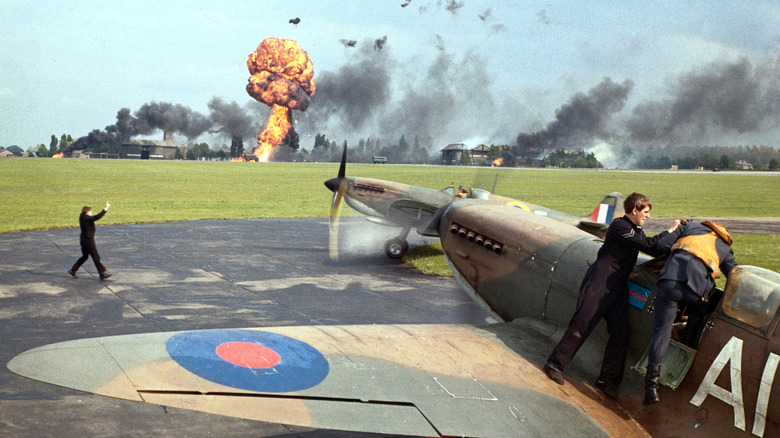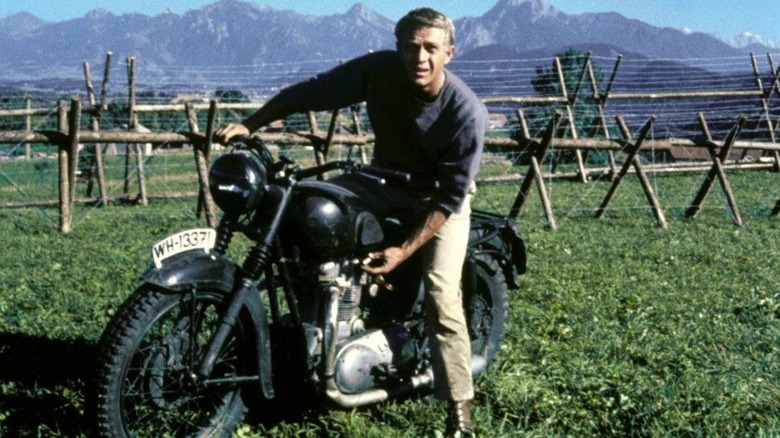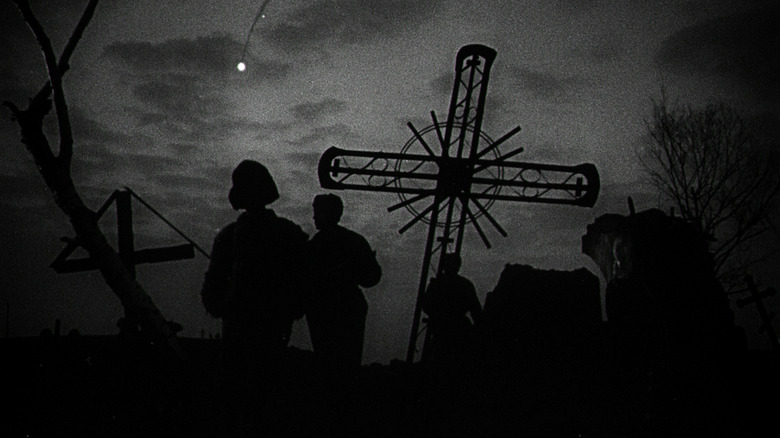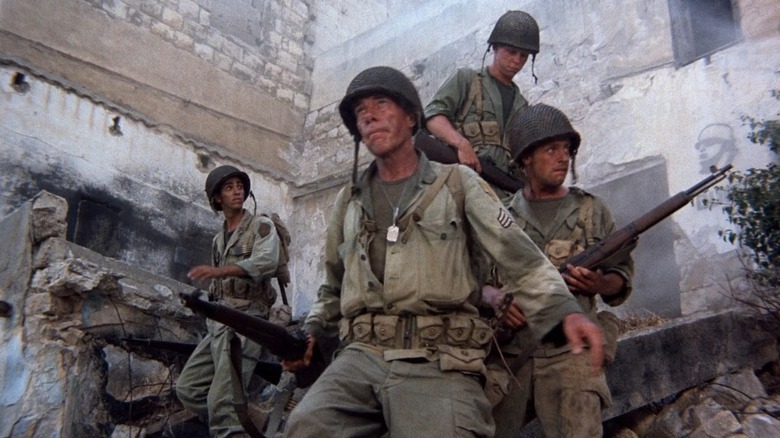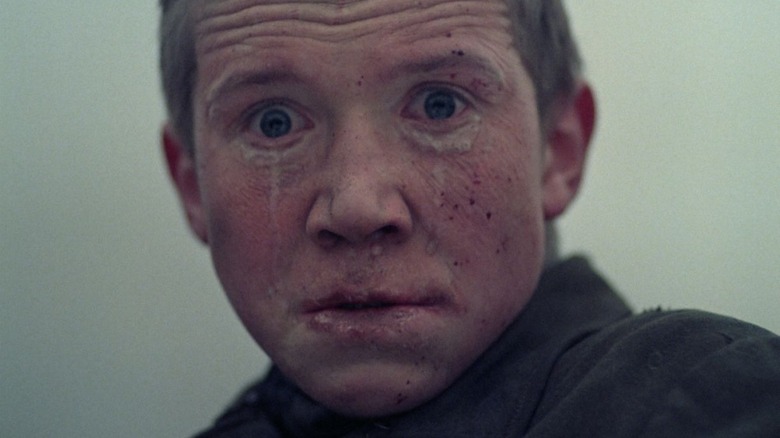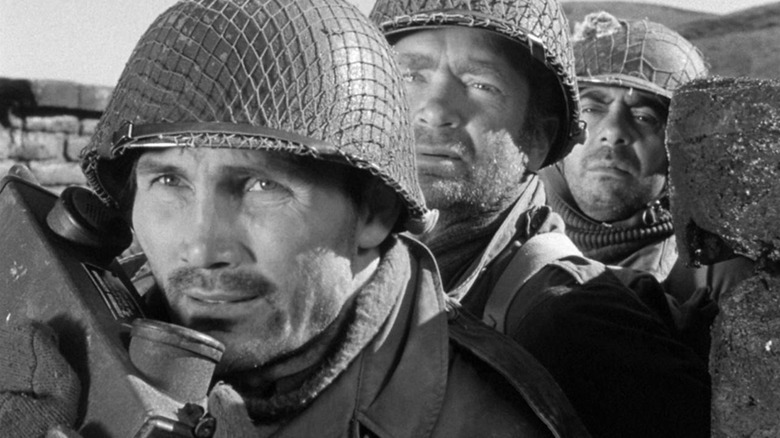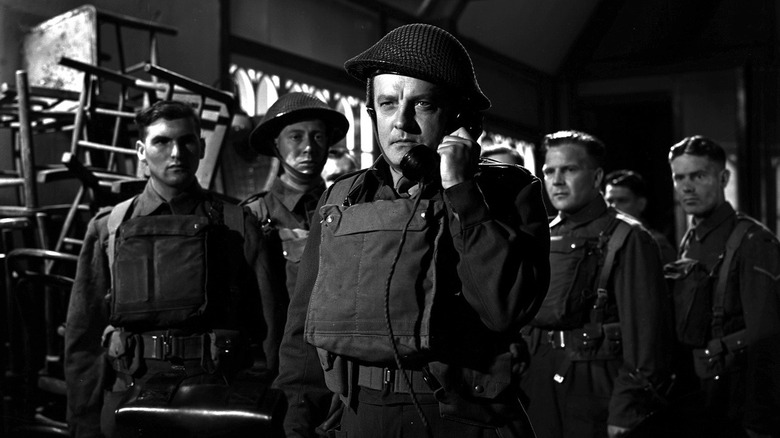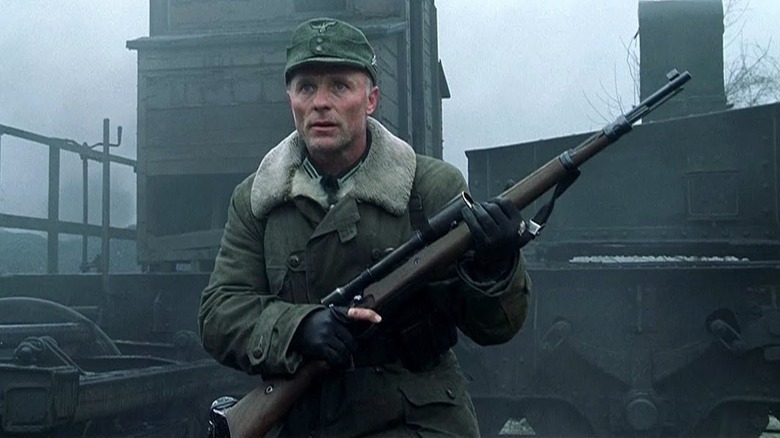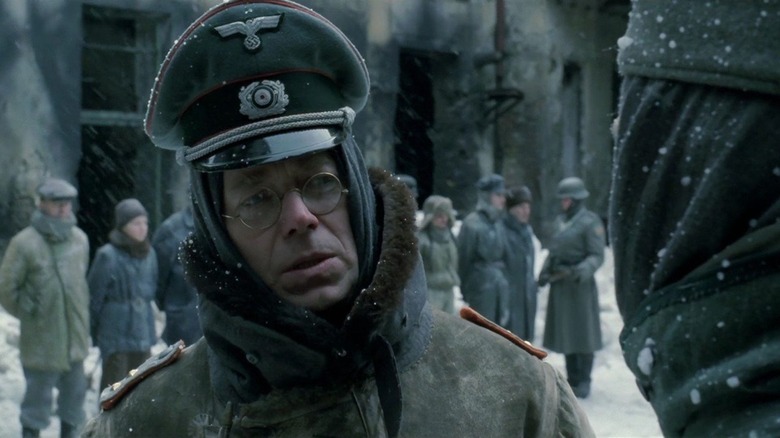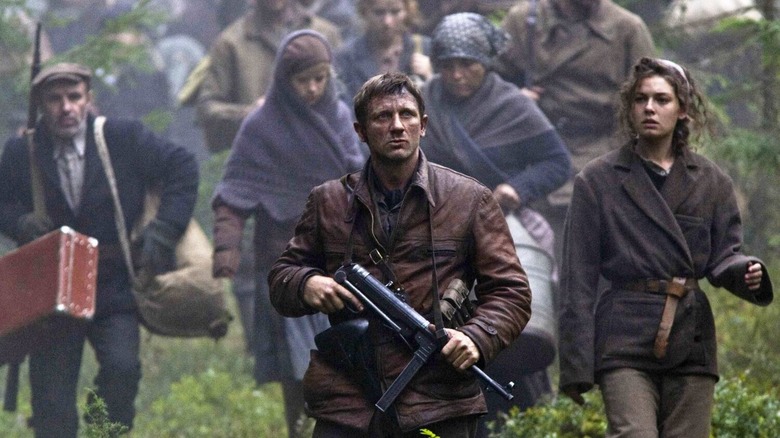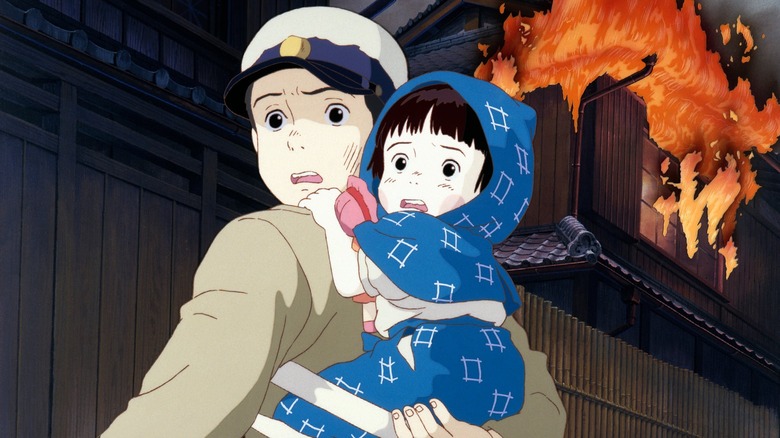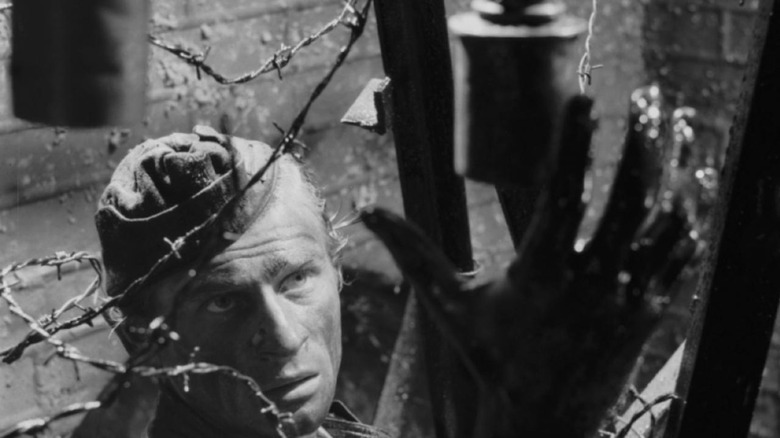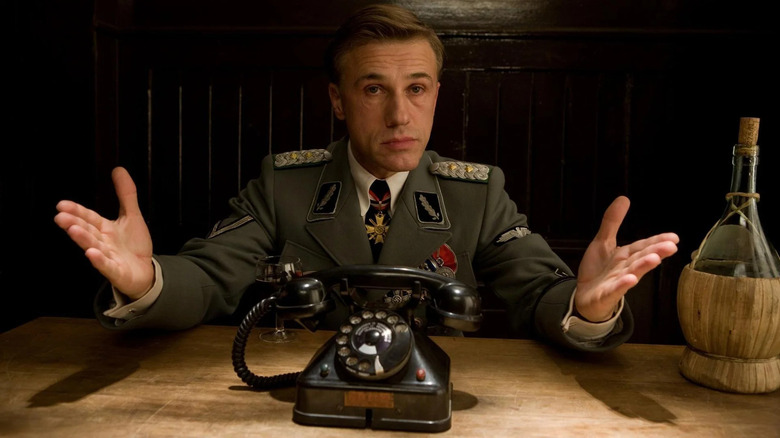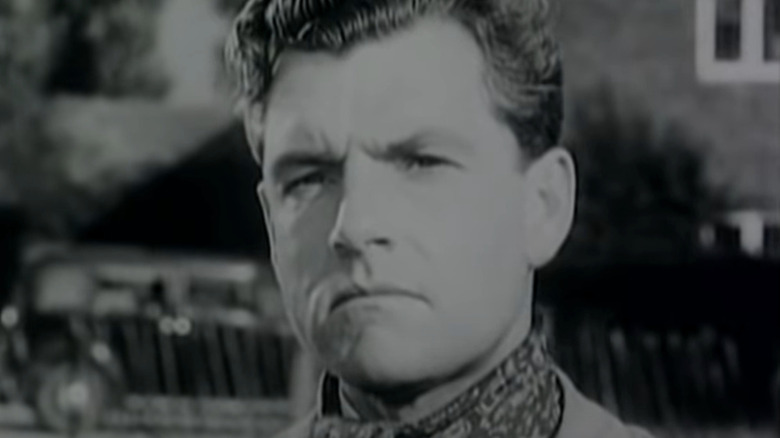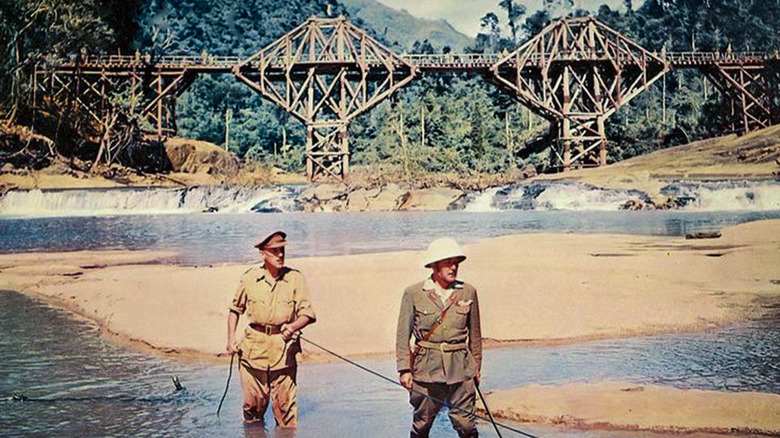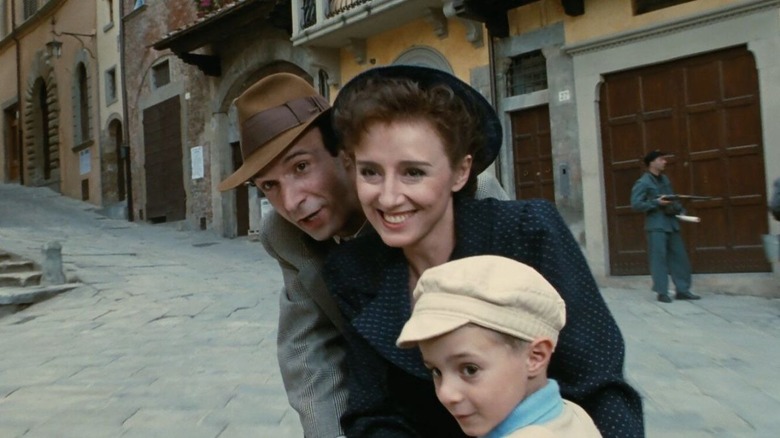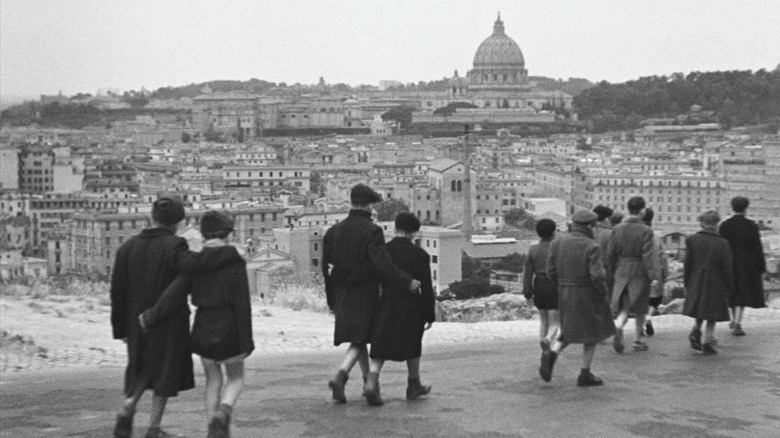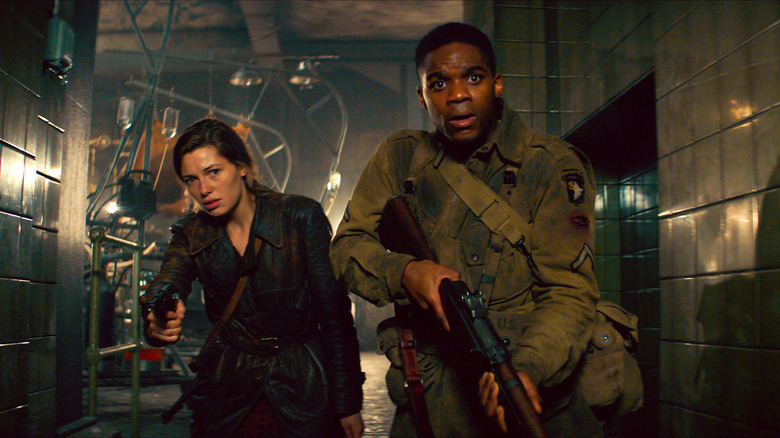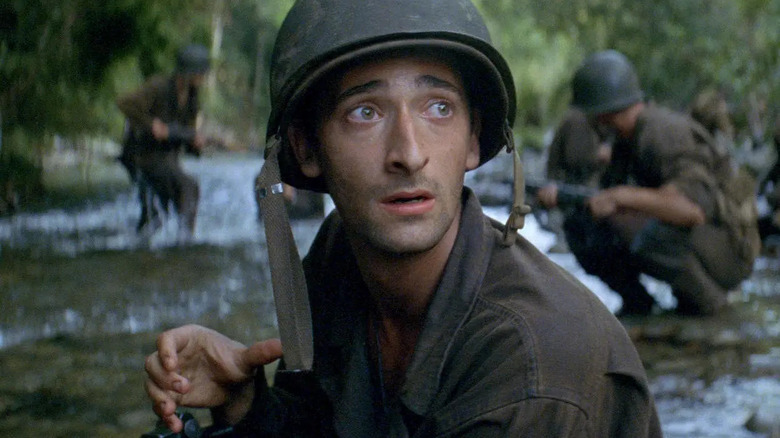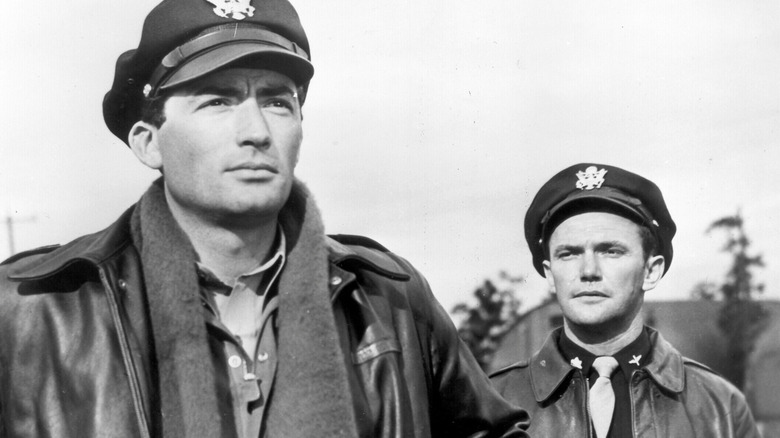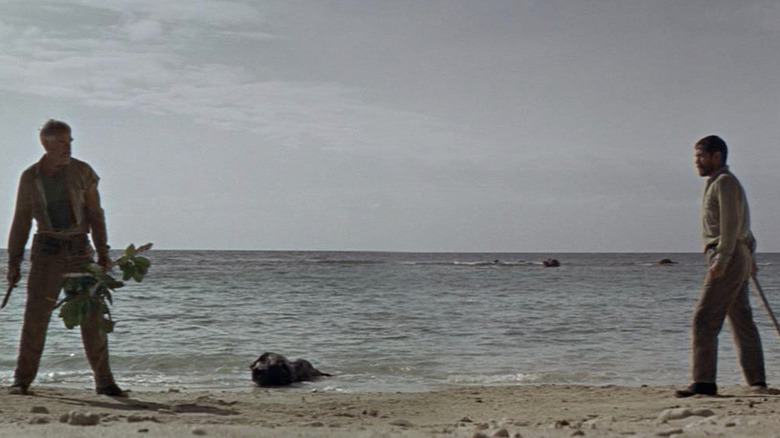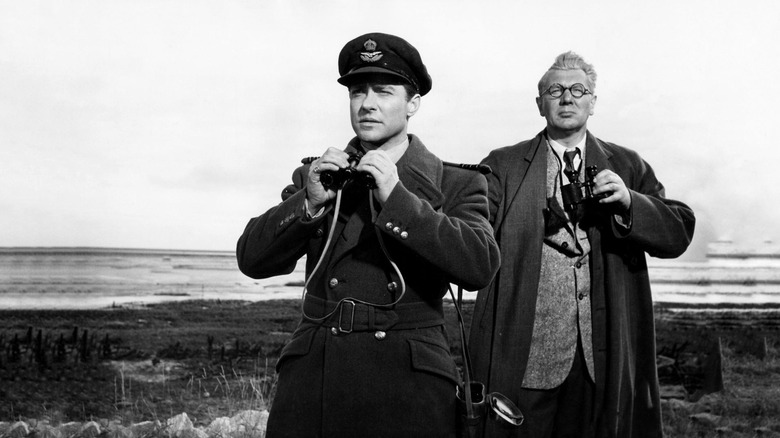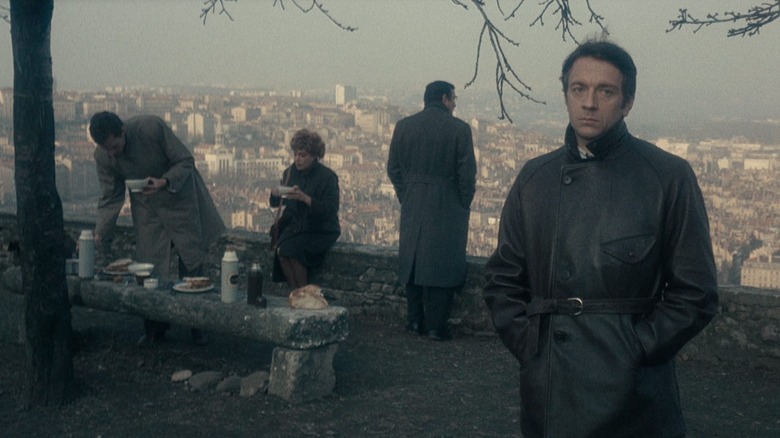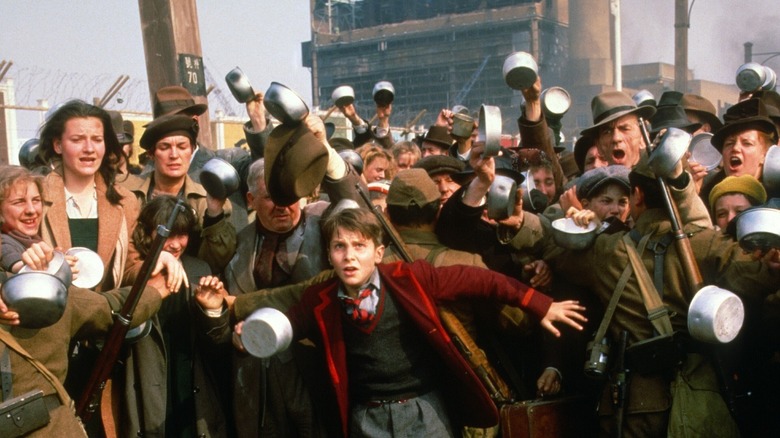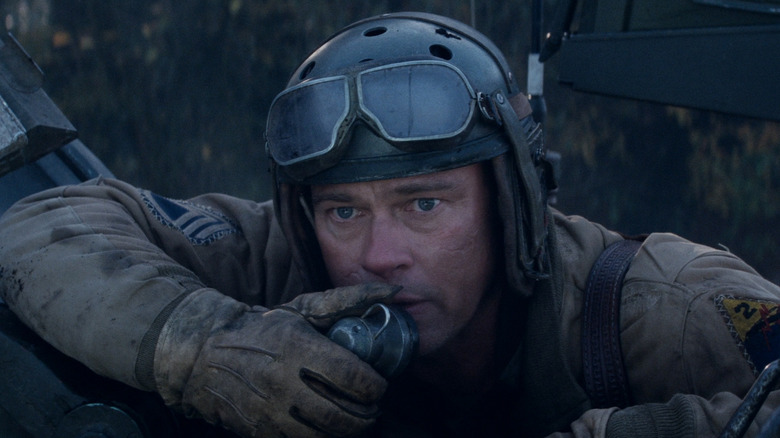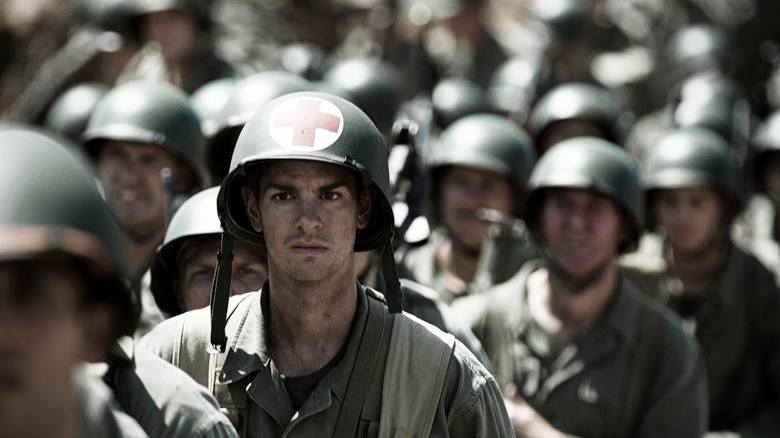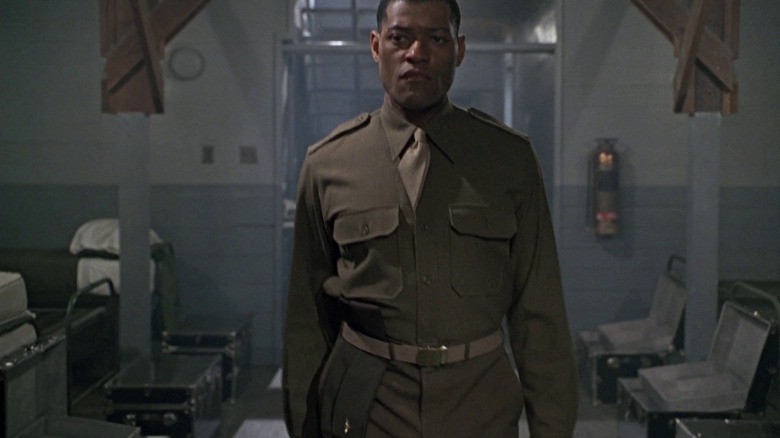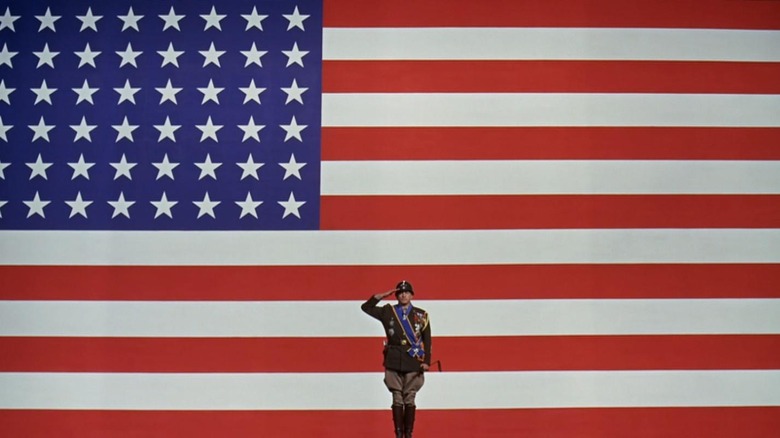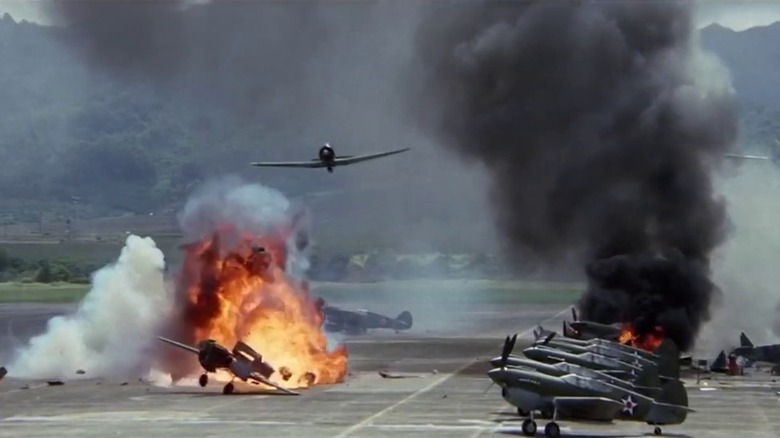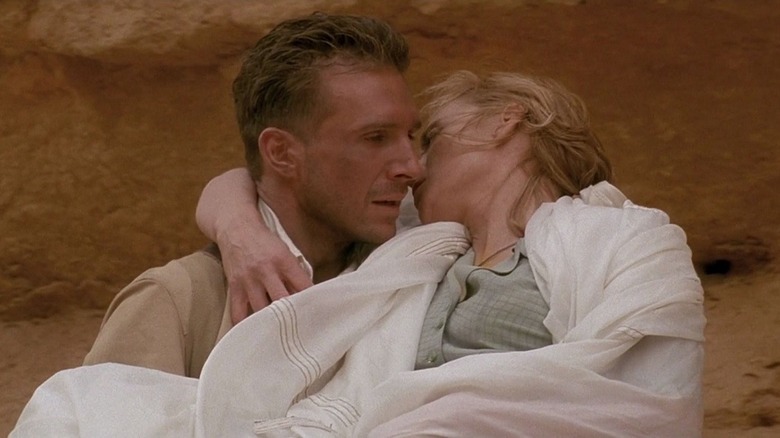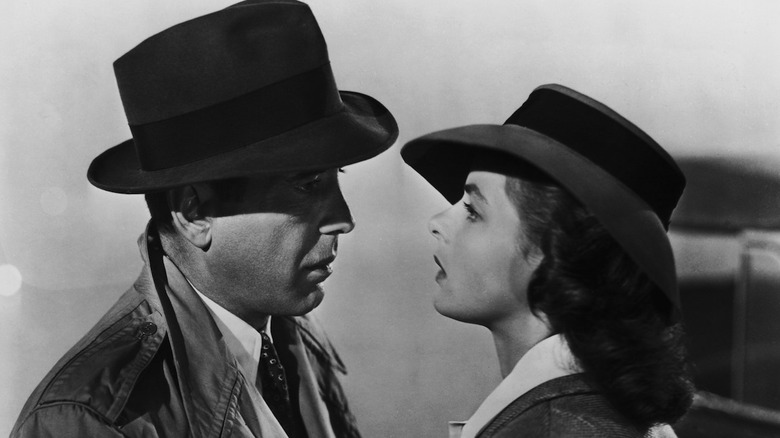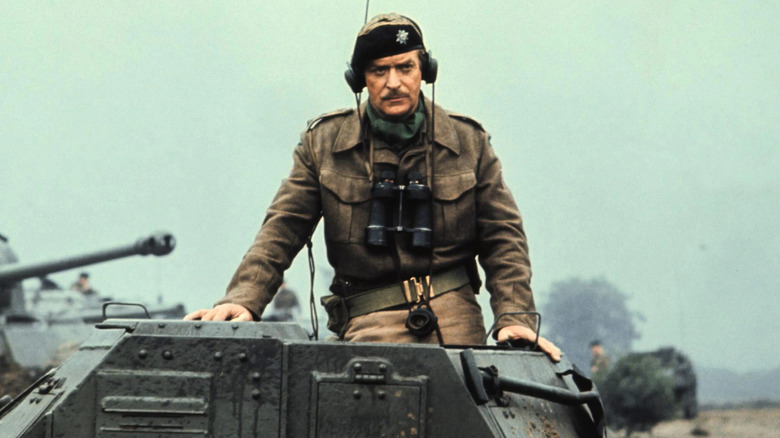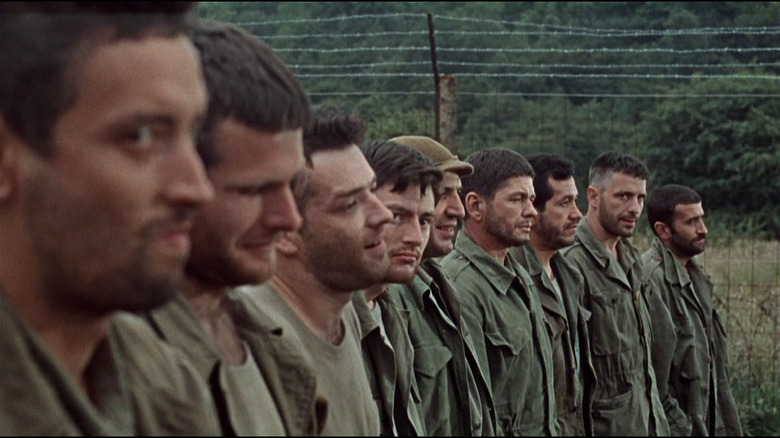50 Movies About World War 2 That Are Perfect For Every History Fan
We may receive a commission on purchases made from links.
Although it was the first World War that earned the moniker "the war to end all wars," a little over two decades later humanity found another reason to wage bloody battle around the globe. Lasting six years and impacting nearly every corner, World War II would earn infamy as the single deadliest conflict in human history.
It should come as no surprise, given the scope of the war and the hundreds of millions of lives it touched, that stories of those who fought would permeate pop culture for the next several generations. What's more fascinating is how popular WWII movies and TV series still are, even as "The Greatest Generation" that fought the war is diminishing in numbers.
Below, a list of some of the best films to take place during WWII. From relatively new releases to films that hit theaters while Hitler was still very much a concern, check them out for the most entertaining history lesson you'll ever receive.
Saving Private Ryan (1998)
Perhaps the most famous movie of the past several decades to be set during the WWII, Steven Spielberg used this R rated drama to put audiences right alongside the soldiers. At the time of its release, the adrenaline-pumping opening sequence became nothing less than a phenomenon, because nothing had ever so successfully made civilians understand what a soldier under fire has gone through.
Featuring phenomenal effects that, at the time of release, were on the cutting edge, the film's intense visuals and an all-star cast of up-and-comers that would largely define the next decade-plus of film (Matt Damon, Vin Diesel, Ed Burns, Giovanni Ribisi and more) could be considered its heavy artillery — if it weren't for the heartbreaking, endearing, Oscar-nominated efforts of Tom Hanks, whose Captain is tasked with leading his men to find a young man (Damon) whose family has already paid the ultimate sacrifice for the country. While the events of the film following the opening assault are fiction, the real life inspiration behind the story is very real.
Downfall (2004)
Long before it became an all-purpose meme featuring Adolf Hitler fuming at the issues of the day, "Downfall" was a critically-acclaimed, Oscar nominated look into the final days of the German high command.
Placing the viewer inside the bunker, it depicts Hitler (in the riveting, horrifying form of a shaky, on edge Bruno Ganz) as his closest aides monitor a dire situation as it becomes completely devoid of hope. Seeing the writing on the wall, many opt to take an easier way out than surrender to the rapidly approaching Soviet Army.
Which isn't to say that the dwindling German Army is depicted simply as cowards who capitulate. Despite near nonexistent supplies and dwindling numbers, the Oliver Hirschbiegel film frequently shifts to a young boy named Peter (Donevan Gunia), conscripted into the Hitler Youth as they delude themselves about the impending collapse of the Third Reich.
Naturally, you know how this story is going to end, and it won't be with Hitler walking away. But the film is effective at both conveying the chaos and desperation of the final days of the war in Europe, and being so vivid in its human portrayals that it makes you glad you've spent time alongside some of the most despicable humans to ever walk the Earth.
The Pianist (2002)
Based on the 1946 memoir of the same name, "The Pianist" documents the life of Polish-Jewish pianist/composer Wladyslaw Szpilman, who lived under the Nazi occupation of Poland. Far from the adrenaline filled scenes of combat that fuel most WWII films, Adrien Brody's Oscar-winning performance is characterized in somber, painful, often quiet moments of struggle as he does what he can to survive amongst a nation in ruins.
Beginning with the simultaneous invasion of Poland by Nazi Germany and the Soviet Union, the Polish army quickly buckles under the combined attacks, with the nation falling under complete control of their enemies. Szpilman's home of Warsaw is soon transformed into a ghetto, with the Jewish population forced into subjugation and barred from most aspects of life. It is during this period that he witnesses some of the worst atrocities of the war at the hands of the occupying SS. The film continues, depicting the attempts to break the stranglehold on the city, eventual liquidation of the ghetto, and Szpilman's desperate bid to survive the war over the years.
Dunkirk (2017)
Christopher Nolan's first war film doesn't skimp on attention to detail, nor the sort of breathtaking cinematic money shots that make you fully aware you're in the hands of a capable storyteller and master of the medium.
Set towards the end of the first year of the war in Europe, Allied troops are on full retreat from France and on the brink of total annihilation after a string of German victories. Standing between the surviving forces and survival is the English channel, seemingly impassable due to limited resources and constant assaults by the German Luftwaffe. With a gripping storyline and a soundtrack to match, "Dunkirk" drives home the hopelessness of the situation on the French coast, while fully immersing the viewer in a compelling historical story of beating the odds.
The Cranes are Flying (1957)
Told from the perspective of a Russian civilian, this female-led film details the high cost of human life the war had on Russian soldiers defending their homeland and the immense suffering those left at home were forced to endure.
The film begins with a young couple, Veronika and Boris, whose happy relationship is shaken to the core by the sudden declaration of war by Germany. Unable to see her love who has now been sent to the front, she vows to await his return. The dramatic escalation of the war and constant aerial bombardments eventually leave her both homeless and an orphan, subsequently forced to live with Boris's family.
Her struggles continue after Boris's cousin Mark forces himself upon her, and eventually shames her into marrying him. The disturbing content of the film and its tragic ending make it one of the most dour films about the Second World War, yet its powerful message and filmmaker Mikhail Kalatozov's unique personal perspective make it one of the most worthwhile.
From Here to Eternity (1953)
Released barely a decade after the events of the film transpired, "From Here to Eternity" featured some of the biggest names in Hollywood at the time, with Burt Lancaster and Frank Sinatra in starring roles and Deborah Kerr, Donna Reed, Montgomery Clift and Ernest Borgnine all turning in memorable supporting work. Set in the months leading up to the attack on Pearl Harbor, the tension of the time serves as a backdrop to its well written character story of love and longing.
Adapted from a novel of the same name, the film won 8 Oscars, including best picture and a best supporting actor trophy for Sinatra, marking one of many comebacks Ol' Blue Eyes launched throughout his career. The 1953 drama is centered around the lives of soldiers living on base, and the romantic complications that arise after a bloody fight changes the lives of the men involved. When the "date which will live in infamy" occurs, however, it shifts the priorities of all involved.
Letters from Iwo Jima (2006)
The best war films are those which understand that everyday people exist on both sides, and no conflict is black and white. Filmmaker Clint Eastwood embarked on an ambitious effort (particularly for a septuagenarian) with a pair of war films in the mid '00's, releasing the companion films "Letters from Iwo Jima" and "Flags of Our Fathers" that focused on the Japanese and American perspectives (respectively) during the battle of Iwo Jima.
The fighting over the island is remembered today as among the most difficult, pivotal battles in Marine Corps history, as well as a stalwart defense by the Imperial Japanese in which the overwhelming majority fought to the death. "Letters" reflects these facts particularly effectively, with many scenes showcasing the tenacious fighting spirit by both sides, despite the Marines facing a well-fortified opponent and the Imperial Army knowing no reinforcements would be coming to their aid.
Das Boot (1981)
Considered by some to be among the most accurate war films, this Wolfgang Petersen classic follows the crew of a German U-Boat in 1941, tasked with hunting down Allied ships. Lurking unseen below the murky waters and dodging Allied vessels aren't the only challenges the crew faces, however, as tensions flare in the cramped living conditions.
A growing divide between more experienced sailors and newcomers is pushed to its breaking point as a result of the high stress environment they endure in the U-boat, with the senior staff on board losing faith in the leadership of Nazi Germany. Their low morale is also affected by the sights the men are forced to bear witness to — in a particularly brutal sequence, the survivors of one of the U-boat's targets are left to drown in the open water. A gritty, claustrophobic film, it speaks to Petersen's talent that we would go on to direct such diverse fare as "The Neverending Story," "Air Force One" and "Troy."
Valkyrie (2008)
This Tom Cruise/Bryan Singer war thriller had him cast as, of all things, a German colonel serving in the ranks of the Nazis. This being Tom Cruise, of course, he wasn't all bad, as his Claus Stauffenberg had lost faith in the command of Hitler and other senior German military leaders and hatched a plot to assassinate the heads of the Reich, alter the future of Germany, and bring the war to an end.
The so-called "July 20 Plot," better known today as "Operation Valkyrie" in reference to the German emergency plan of the same name, involved an intended use of the German reserve army to seize control of the country, entailing the simultaneous assassination of both Hitler and Heinrich Himmler through the means of an explosive briefcase.
As the film depicts, a tense back and forth between Stauffenberg and his co-conspirators nearly causes the assassination to never be attempted, however they ultimately decide to carry it out. The movie provides fascinating narrative backstory into how this bold assassination attempt was launched, and why it was never successfully realized.
Memphis Belle (1990)
A claustrophobic story set largely inside the cabin of a B-17 flying fortress of the same name, this period-specific Michael Caton-Jones drama follows its crew as they carry out high stakes missions in the skies above Germany. The 12 men that make up the Belle's air crew, each with their own unique personalities (and populated by familiar faces including Matthew Modine, Eric Stoltz, Sean Astin and Harry Connick, Jr.), are collectively assigned to one last mission, naturally the most dangerous of their lives.
Tasked with reaching and destroying a German aircraft factory, the fighter escorts accompanying the Memphis Belle are forced to break formation once their fuel runs low, leaving the bomber formation vulnerable. Unabashedly cinematic if a bit cliche-heavy, "Memphis Belle" is nonetheless a thoroughly enjoyable war film, even if it does at times cast aside realism in the name of myth-making.
The Imitation Game (2014)
As England faces off against Nazi Germany in the early days of the war, its seemingly uncrackable enigma machine remains a huge obstacle for the British military. Capable of communicating encrypted messages throughout the Third Reich, the opposition hopes to uncover its secrets and in turn gain a huge advantage.
Working as part of a varied team trying to crack the code is Alan Turing (Benedict Cumberbatch), who begins to theorize and construct a machine capable of breaking it. But while his own detached demeanor draws the ire of his colleagues and threatens to derail the mission, it's hard to deny that his brilliance might just be the key to intercepting the enemy's most vital communications.
Although the film earned glowing reviews (and earned Cumberbatch an Oscar nomination), "Imitation" has since received some blowback for historical inaccuracies and not fully addressing Turing's homosexuality. Despite that, it effectively honors the man's contributions to the Allied war effort, and is greatly elevated by one of Benedict Cumberbatch's finest performances.
The Longest Day (1962)
Before Spielberg gave us "Private Ryan," "The Longest Day” was the gold-standard film covering the Normandy Landings. A multinational ensemble with the biggest names in cinema at the time (John Wayne, Robert Ryan, Henry Fonda, Eddie Albert, Red Buttons and Sean Connery's last performance James Bond would make him a superstar), "Longest" matches the epic scope of the battle, though some performances do admittedly get lost in the sea of humanity. Nevertheless, the performances that do stand out are thrilling.
Largely sidestepping the melodrama that bogs down many war films, the events of the D-day landings are told in a style resembling a documentary. A number of great set pieces help keep the film engaging, but it's hard to argue that some audiences who don't consider themselves hardcore history enthusiast might have trouble staying fully engrossed for its three hour runtime.
Schindler's List (1993)
Another entry from Spielberg, "Schindler's List" predated "Saving Private Ryan" by five years, but makes an excellent companion piece.
An entirely different look at the war in Europe, this film is based on the real-life heroism of Oskar Schindler, a wealthy factory owner and member of the Nazi party operating in Krakow, Poland. As the war progresses and construction of the concentration camps are completed, the German high command enacts the last step of the final solution, with the violent liquidation of the Krakow ghetto being a turning point in Schindler's perception of the war.
Determined to save as many as possible from certain death, Schindler does whatever his wealth and status will allow, with the titular list being a number of Jews to be sent to one of his newly-constructed factories rather than the death camps. With striking visuals, incredible acting and one of the most important stories of the war to be told, "Schindler's List" is worthy of its distinction of the greatest war films of all time.
Flags of Our Fathers (2006)
This companion piece to "Letters from Iwo Jima" had Eastwood chronicling the events of the Battle of Iwo Jima as the Marines saw it.
As the first days of the battle go by with seemingly endless bombardment of the island by the U.S. Navy, the order is given to begin the landing. Facing no resistance until they are fully disembarked, the Marines soon find themselves in one of the most desperate struggles of the war.
The events grow more desperate as a mounting loss of life and determination of its defenders cement one of the most hard fought victories in American history. Though not as well received as "Letters from Iwo Jima," Eastwood did a commendable job portraying the events of the battle, making it a worthwhile watch for any history buff.
Where Eagles Dare (1968)
Starring Richard Burton and Clint Eastwood as Allied officers on a high stakes mission deep behind enemy lines, it's hard not to love this classic war thriller.
After a senior U.S. Army general is captured by the Germans and held in a remote prison atop a mountain, the two leads are accompanied by a small team and sent to go undercover in enemy uniforms and infiltrate the compound. Parachuting into the remote German Alps as they make their way to the castle in which their target is being held, the mission quickly goes horribly awry, forcing our heroes to fight their way out if they want to survive.
Full of twists and turns, it soon becomes apparent that not everyone is who they say they are, nor does everyone have the same idea of their ultimate mission. While "Where Eagles Dare" is now over 50 years old, it still holds up as a great watch for any fans of war films — with a good bit of espionage thrown in for good measure.
Son of Saul (2015)
Critically acclaimed, the Academy Award-winning "Son Of Saul” is one of the most impressive narrative films to ever touch upon the subject of concentration camps.
The film follows the life of Saul Auslander, a Jewish-Hungarian prisoner in Auschwitz, as well as the horrors he is forced to witness. Drafted against his will into one of the many work units at Auschwitz, his is known as the "sonderkommando," composed of fellow prisoners tasked with aiding in the mission of the death camp by looting and transporting the recently killed.
After witnessing the murder of a young boy, Saul does everything in his power to provide him with a proper burial, in line with Jewish tradition. He soon learns that several fellow prisoners are plotting a rebellion, one in which Saul hopes his participation will help him become a rabbi, capable of carrying out the ceremony. Whilst trying to evade the notice of his captors, his situation becomes increasingly complex as the revolt is carried out by the prisoners. While at times hard to watch, "Son of Saul" accomplishes its goal of presenting a raw, matter-of-fact re-telling of one of humanity's darkest moments.
Cross of Iron (1977)
Released in 1977, "Cross of Iron" is just as much about the war being waged on the Eastern Front as it is about the battles being fought within the German Army, particularly the divide between officers and their enlisted men.
Jaded, battled-hardened Corporal Steiner (James Coburn) is at the heart of the story, as he becomes disillusioned with his leadership over the events of the film. Motivated only by a desire for personal glory, Steiner's corrupt Captain Stransky (Maximilian Schell) embodies everything Steiner despises about his leadership. Stransky, seeking nomination for the prestigious Iron Cross, is willing to do seemingly anything to assure it is achieved.
When Steiner refuses to corroborate a bogus application for the award, the divide between Stransky and Steiner reaches a boiling point. Amongst counterattacks by the Russians and the fog of war, Stransky makes a deadly decision in the hopes of exacting revenge on his uncooperative subordinate.
The Battle of Britain (1969)
Following the loss of France to the German onslaught, a desperate defense was prepared for the inevitable aerial bombardment of Britain. But when a surprising delay under Hitler's leadership gave the strapped-for-time Royal Air Force much-needed days to prepare, the balance in a key battle was shifted.
The Guy Hamilton-directed "Battle" features Michael Caine, Christopher Plummer and Robert Shaw in a tale that spans months, including a final epic battle that resulted in a resounding blow to the Germans. While coming at a great loss of life and machinery, the successful defense of the island gave hope that the previously unstoppable advances of the Third Reich could be halted.
Despite favorable audience reviews, critics were less enthusiastic; while it leans heavy on the cliches, however, "Battle" is recommended to audiences looking for a film with authentic aircraft and battle strategy.
The Great Escape (1963)
Inspired by multiple real-life escape attempts by Allied prisoners of war, this John Sturges classic was somehow only nominated for one Oscar (for editing), yet became a classic thanks to its thrilling sequences and incredible stunts — which also helped make Steve McQueen one of the biggest stars in Hollywood.
Deep in German territory in the middle of the war, a large group of Allied prisoners begin to concoct a scheme to escape high security prison. Evading the suspicions of the prison guards and methodically tunneling to freedom proves hard enough, but they quickly realize once outside the prison walls that truly escaping the threat of the Germans is far more difficult.
Clever disguises, classic motorcycles, and heart-pounding deception powers the film, along with classic performances by one of the greatest casts ever assembled: McQueen, Coburn, Charles Bronson, Richard Attenborough, Donald Pleasence, and of course, James Garner as "The Scounger." Quite simply, it's one of the most exciting war films ever made.
Ivan's Childhood (1962)
Due to the invasion of the Soviet Union and the losses they endured, many Russian-produced WWII films carry a more somber tone than their Western counterparts. "Ivan's Childhood" is no exception, showing the devastation of the war through the eyes of a child.
When young Ivan (Nikolay Burlyaev) stumbles upon a trio of Russian soldiers, he joins them as a scout. The dreamlike, nebulous nature of the film is reflected in Ivan, however, as his true loyalties are perpetually unclear.
Bold and artistic, with a runtime of just over ninety minutes, "Ivan's Childhood" bucks the trend of long, verbose war films; that makes it no less powerful. Devastating, haunting visuals and a bleak ending make for a somber viewing experience you won't soon forget.
The Big Red One (1980)
Writer/director Samuel Fuller called upon some of his own real-life experiences in WWII for this film about the 1st Infantry Division of the U.S. Army (named after the distinctive insignia worn by them). Shot for a modest budget of $4 million and starring Lee Marvin and a fresh-from-"Star Wars" Mark Hamill, "The Big Red One" is stark, brutal and unrelenting.
The globetrotting epic takes viewers through many of the major campaigns of the European Theatre, through the eyes of a handful of American G.I.s. After fighting seemingly endless battles and losing countless lives over the years, the camaraderie shared between the surviving men only serves to isolate them from newcomers to their squad. As the war approaches its conclusion, so too does the time the men spend together, with a final scene bringing the entire film full circle with a poignant closing message.
While the theatrical release is just under two hours long, the restored version (in excess of four hours) is well worth the watch if hardcore fans want to bask in Fuller's original vision.
Come and See (1985)
One of the most intense WWII films ever made, powered by a resoundingly anti-war message, "Come and See" marked the final film by Russian director Elem Klimov. Remembered decades later for its unflinching, disturbing imagery depicting the horrors of the Nazi occupation and oppression of Soviet Byelorussia, it's about as raw and unfiltered as a war movie can be.
Following Flyora, a young boy with aspirations of joining his nation's partisan army and repelling the invaders, his world view is shattered when he's confronted with the carnage of the conflict. Following a resounding defeat at the hands of the German occupiers, narrowly avoiding death, Flyora returns to his village to find it seemingly abandoned.
In one of the film's most chilling scenes, the true fate of the villagers is shown to be far worse than he could imagine. The film's artistic stylings give it a haunting, dreamlike quality.
Attack! (1956)
Jack Palance, Lee Marvin, Buddy Ebsen and Eddie Albert star in this Robert Aldrich effort, one of the grittier films on the war, especially at a time of release that still leaned towards sweeping, romanticized efforts.
Depicting a U.S. Army Captain's downward spiral, and the grave effects it has on the men he's tasked with leading, "Attack!" unfolds in late 1944 as the Fragile Fox unit under the command of Captain Cooney (Albert) bungle an assault with deadly consequences. As the cracks in the unit reveal themselves, their cohesion is put to the test as the last major German offensive at the Battle of the Bulge puts Cooney's men in the crosshairs.
Went the Day Well? (1942)
Unique for being produced as the events of the war were ongoing, the 1942 film "Went the Day Well?" played off the very real fear among the British populace that a German invasion could be imminent.
Set entirely in the remote town of Bramley End, suspicions are raised when a group of soldiers staying in the town raise suspicion; the longer they remain, the more evidence piles up that they are not what they seem.
When the soldiers' true mission is revealed, the townspeople go into full revolt. Long before "Red Dawn," "Went the Day Well?" pondered the question of what a home grown resistance to an outside invasion would resemble.
Enemy at the Gates (2001)
From writer/director Jean-Jacques Annaud comes this tale of a Russian and German soldier who turn the battlefield into their own game of manipulation, standoff and slaughter.
Despite sustaining the greatest number of losses during the war, it's not often viewers are exposed to films showing the Russian struggles during the Second World War. After a blatant violation of the already immoral German-Soviet nonaggression pact (which assured peace between Nazi Germany and the Soviet Union), an aggressive assault by the combined arms of the German military made steady advances into Russian territory, finally coming to a halt at the city of Stalingrad. The battle, considered the single deadliest in human history with a combined two million deaths, is the setting for "Gates."
In a war defined by its inhuman acts of brutality, the defending Soviet Army here is shown to resort to the same barbarism as their invaders. Starring Jude Law, Ed Harris, Rachel Weisz, Ron Perlman, Joseph Fiennes and Bob Hoskins, the film may have received a mixed reception from critics and audiences (many unhappy with the disjointed central romance storyline) but it's still one worth watching.
Stalingrad (1993)
If you want to counterbalance "Enemy at the Gates," make it a double feature with this 1993 look at the battle from the other side's perspective.
Showing the events surrounding the German Army's confident advance, followed by a sudden stalemate in the city, the film doesn't shy away from the true brutality of its events.
Optimism turns to desperation for the invading army as winter sets in; undersupplied and on the brink of encirclement, the German Sixth Army sees the writing on the wall. Some of the men mutiny, hoping to escape the inevitable collapse of their offensive. Others resort to an easier way out instead of surrendering to the enemy. With an ending as bleak as the fate of many who fought in the battle, this film's potent anti war message is a powerful one.
Defiance (2008)
Centered around the resistance to the Nazi occupation of Byelorussia, and particularly the life and exploits of Jewish partisan Tuvia Bielski, this Edward Zwick film tells a powerful tale about the human spirit.
As portrayed by Daniel Craig, Bielski is shown leaving behind his former life, driven from his home and forced to take refuge in remote forests to avoid being discovered by Nazi death squads. He isn't the only one to have this idea, however, as increasing amounts of Jewish refugees boost his numbers by the day, amounting to a small but determined group of survivors. Relying on their wit and practical skills to get by, they at times go on the offensive against the occupying Germans and those who have sided with them.
Over time, the scattered group of partisans and civilians begin to form a makeshift settlement, which will persist until the war concludes. Despite mixed reviews, "Defiance" is worth checking out, if for no other reason than to see a rarely-depicted side of the war.
Grave of the Fireflies (1988)
Anyone familiar with Studio Ghibli likely associates the name with some of the most beautiful, heartwarming animated films ever made. It might come as a surprise, then, to find out that one of the studio's earliest films "Grave of the Fireflies" is anything but — though it also isn't the work of their best known director, Hiyao Miyazaki, but of another talented director named Isao Takahata.
Set in Japan during the late war period, the skies overhead are littered with American bombers, dropping simple but deadly firebombs across the country. The struggle to survive the chaos is shown through the eyes of a young boy and his even younger sister, with the dangers overhead not being the only hardship the pair are forced to endure. One of the first films to establish animation as a respectable tool for filmmaking, "Grave of the Fireflies" has endured as one of the most devastating anti war films ever made, as well as a highlight for the studio that made it.
Kanal (1957)
Set during the final days of the failed Warsaw Uprising, in which thousands of Polish resistance fighters attempted to liberate the city from Nazi occupation, "Kanal" shows the desperate plight of some of the last survivors as they try to escape certain death. With no option left but to flee into the city's sewers, the disorganized group of fighters are joined by a handful of civilians as they try to navigate the complex underground tunnels in the hopes of reaching freedom.
As they plod through the dark, maze-like sewers underneath the occupying German military, the group's cohesion begins to crumble and their numbers slowly dwindle. Succumbing one by one to injury and madness, the odds of any of them reaching the surface alive seem more improbable by the minute. Bleak, claustrophobic, and tragic, "Kanal" is a fitting film about a grim chapter of the war in Europe.
Inglourious Basterds (2009)
Quentin Tarantino made his name with unique storytelling and ultra violent action scenes, and he didn't disappoint when it came time to make his first war film. One of the few WWII movies that could be described as "fun," the over-the-top action and stark visuals of "Basterds" work in tandem to tell a fictionalized, revisionist history tale of how the war could have ended.
Brad Pitt stars as Aldo Raine, commander of a special group of American soldiers dropped behind enemy lines and tasked with taking down as many Nazis as possible in a form of psychological warfare. They end up taking on a much more important mission, however, when they're sent to infiltrate a theater and assassinate the heads of the Third Reich.
If you're willing to set aside historical accuracy aside and simply indulge in a wild ride, "Basterds" is a must watch.
Reach for the Sky (1956)
A biographic title focusing on the military service of Group Captain and British combat ace Douglas Bader, "Reach for the Sky" portrays him as a hero of the war in a film that would make the true-to-life figure much more recognizable.
Joining the Royal Air Force long before WWII broke out, an acrobatic stunt gone wrong left Bader crippled, forcing amputation of both his legs. Barred from flying, Bader doubles down on learning how to use his prosthetic legs, trying to convince the Royal Air Force to let him fly again.
As the interwar period ends and a desperate need for pilots is soon realized, Bader once again applies, this time granted a command slot over a broken down, defeated squadron of pilots. While successful in both improving their combat effectiveness and leading successful missions over Nazi occupied France, when he is shot down over enemy territory Bader gets thrust into an entirely new struggle — to get home alive.
The Bridge on the River Kwai (1957)
An Academy Award winner for best picture, this David Lean epic isn't just a perennial contender for best war film ever made, but also best movie ever made.
Nearly three hours long, it focuses on the lives of Allied forces trapped in a Burmese prison camp by the Japanese and forced to construct a bridge to aid in the war effort. With the historically deadly construction of the Burma Railway serving as inspiration for the film, the conditions in the camp put every one of its prisoners to the test.
The primarily British captives initially resist cooperating with the Japanese, led by the tyrannical Colonel Saito. Cracks begin to form in their resolve however, when one of the British officers goes rogue, accused by the others of being a collaborator when he seemingly sides with his captors. In reality, the construction of the bridge has become a battle for both Saito and the defiant Nicholson (Alec Guinness, in what would be his most famous role until that whole Obi-Wan thing came along), with the pride of each man on the line.
As incredible character drama less about the wider war at play than how the will of each man perseveres (or crumbles) when pushed to their breaking point, "Kwai" will leave you whistling in appreciation.
Life is Beautiful (1997)
Written, directed and starring Roberto Benigni, once upon a time this film became an absolute phenomenon that led all the way to three Oscars. In the decades since, many have turned against its seemingly ill-advised desire to turn one of humanity's darkest chapter's into a comedy, but if you give it a chance, you'll see why it was able to cast a transcendent spell on late-'90s audiences.
The film follows the life of Guido Orifece (Benigni), an Italian Jew supporting his family during the ongoing war. After the collapse of fascist Italy and subsequent Nazi occupation, Orifece's family is one of many sent to the death camps. To shield his son from the true nature of the camp, Orifice tells him that their fellow prisoners are actually contestants in a game, with the prize being a tank. While such games protect his son's innocence in the face of untold atrocities, the rules Orifice tells his son to obey serve a dual purpose, keeping him alive and out of sight of the camp guards.
While it sounds near impossible to set a comedy during one of humanity's darkest chapters (just ask Jerry Lewis), especially in a way that doesn't come off as tasteless, "Life is Beautiful" excels at it.
Rome, Open City (1945)
Following the fall of fascist Italy, and subsequent declaration of Rome as an open city, swift Nazi occupation ushered in an era of brutality amongst its population. This Roberto Rossellini film crystallizes the memories of what transpired during this dark period in Italian history, fresh in the minds of Rossellini (and, notably, screenplay collaborator Federico Fellini) as they attempted to portray the events that transpired in the aftermath.
Shot in the same city the film's events took place in less than a year prior, "Rome, Open City" follows an array of characters as they struggle under a shared plight, some opting to risk their lives to resist occupying forces, others simply trying to keep their heads down and survive. Blurring the line between film and documentary, particularly in its matter-of-act presentation, the viewing experience is like you're watching a historical journal come to life.
The first work of an unofficial trilogy by Rossellini, his accompanying two films "Paisan" and "Germany, Year Zero" are also worth taking a look at as additional entries employing this unique style.
Overlord (2018)
Standing out from the competition, this WWII film might be a zombie flick produced by JJ Abrams, but that doesn't mean it isn't historically compelling.
Based on a story by Billy Ray ("Shattered Glass"), film asks and answers the burning question of what the war would have looked like if the Nazis counted the undead among their ranks during the Normandy landings. Stars Jovan Adepo, Wyatt Russell and Bokeem Woodbine are along for the wild ride.
Amidst the chaos and confusion of the airborne assault on Normandy, Allied soldiers push into enemy territory expecting to meet stiff resistance. What they don't expect, however, is the discovery of secret Nazi laboratories that have housed experiments resulting in an entirely new, dangerous enemy. In case the theatrical release poster didn't clue you in, the blood and gore filled "Overlord" easily earns its R rating.
The Thin Red Line (1998)
Terrence Malick's high-profile return to the director's chair after a 20-year-sabbatical had him relaunching and significantly expanding a stream-of-conscious, exposition-free auteur style he had once helped pioneer. Appropriately enough, a murderer's row of Hollywood heavyweights — Adrian Brody, Sean Penn, George Clooney, Woody Harrelson and more — signed up to portray the emotional and spiritual perspectives of his characters, searching for life and meaning while surrounded by death and confusion.
Set during the bloody Battle of Guadalcanal, the U.S. Army soldiers tasked with taking control of Mount Austen have their combat skills and mental strength put to the test against a seemingly insurmountable defense. Frequently trading realism and structure for the sake of artistry, "The Thin Red Line" remains a worthwhile watch if you're willing — like any Malick film — to release traditional expectations of characters explaining every motivation and plot point and instead allow it to wash over you.
Twelve O'Clock High (1949)
Released just a few years after the conclusion of the war, this Gregory Peck classic flashes back to the earliest day of American involvement.
Following costly bombing raids of targets across Germany, a string of losses has left the 918th bomb group battered and demoralized. When outside forces investigate the leadership, they find that the group commander's careless attitude has spread to the rest of the air crews, leaving them ineffective. Newcomer General Savage (Peck) is tasked with improving combat effectiveness by restoring the group to its maximum strength, which proves to be an uphill battle.
Initially, the men rebuff his new command style, defined by harsh punishments; many of the pilots request to transfer out. When the time comes for those same pilots to carry out one particularly high stakes mission, however, their unity is put to the test alongside Savage's capability as a commander.
Hell in the Pacific (1968)
A high-concept John Boorman flick, "Hell in the Pacific" tells a story familiar to any seasoned "Star Trek" fan, yet a welcomed change for anyone expecting typical war movie touchstones.
Screen legends Lee Marvin and Toshiro Mifune star in the film, telling the tale of two soldiers stranded on an island who just so happen to be from opposite sides of nations at war. Their mutual distrust isn't helped by a language barrier, though the shared struggle to overcome the unforgiving conditions on the island soon forces the men to cooperate. By the time the film is over, the pair have deconstructed the concept of an enemy — though that doesn't necessarily mean they've become friends.
Light on dialogue and with two wildly different endings, "Hell in the Pacific" lacks many of the hallmarks of your typical war movie. Large set pieces and high octane action won't be found in this one, but an important message about the futility of warfare is central to its unfolding story, with precise details surrounding the war itself taking a backseat to the character drama at play.
The Dam Busters (1955)
While most war films tell stories of battles won through sheer numbers and bravado, the conflict in "The Dam Busters" relies on scientific ingenuity to win the day. Based on a real life account of the film's main character (played by Richard Tood), it chronicles the exploits of the Royal Air Force's mission to destroy German dams, and the scientists who made it possible.
The real life figure of Barnes Willis (portrayed here by Michael Redgrave) is shown desperately trying to develop his theory of a bomb capable of bouncing on water. He theorizes that his invention would be key to dealing a devastating blow to the German war effort, thanks to its ability to knock out their industry — yet his superiors refuse to support the concept.
Turning to a senior member of the same bomber forces that would use the new weapon, he finally gets the support he needs to make it a reality. After a number of setbacks and dangerous training runs to test the equipment, the high stakes assault is carried out — and the results may surprise you.
Army of Shadows (1969)
As countries gradually fell under the control of the Axis powers during the early years of the Second World War, homegrown resistance movements cropped up, serving as the last line of defense in an effort to disrupt the occupying armies. The French Resistance, one of the most notable of these movements, is the subject of the 1969 Jean-Pierre Melville drama "Army of Shadows."
While their exploits were undoubtedly admirable, the heroes of this story aren't portrayed as such. Instead, the stark reality is shown, with gritty, matter-of-fact exploits of the resistance movement taking center stage. The struggles of its members, and the choices they make, are all indicative of a people whose wills are at their breaking point.
While it's rare to find a war film that restrains itself to this degree, "Army of Shadows" refuses to sugarcoat the conflict from any perspective, giving the events that transpire far more impact.
Empire of the Sun (1987)
Notable for kickstarting the career of Christian Bale at age 13, the future star's first major role is as much a story about the wider war as it is a coming of age tale.
"Empire of the Sun" serves as one of multiple films Spielberg has made with war as a backdrop, and was nominated for six Oscars, yet somehow stands today in the shadows of his other works. Nevertheless, it deserves to be seen.
Depicting the son of a wealthy family of British transplants living in Shanghai, the family's affluent lifestyle comes to a screeching halt as the Japanese invade and occupy the city. In the ensuing panic and evacuation, Jamie Graham (Bale) is separated from his family and imprisoned in an internment camp. While there, he learns how to survive, befriending a boy not much older than him on the outside who is training to become a Japanese pilot. Though the Japanese occupation is nearing an end, the imprisonment will leave him forever changed — if he can make it out alive.
Fury (2014)
Brad Pitt stars as a tank commander alongside Shia LaBeouf, Michael Pena, Jonathan Bernthal and Logan Lerman as the rest of his Sherman tank crew with this acclaimed, adrenaline-fueled David Ayer flick. As their vehicle inches deeper into Germany during the closing days of the war, gritty violence and the brutality of warfare become central themes to the story.
Featuring real tanks and heavily inspired by accounts from actual armor crews, the film does take some creative liberties for the sake of cinematic visuals in regards to some of the on-screen tactics, but is nonetheless a well-acted, gripping watch for any fan of World War II stories. The journey of the battle-hardened crew of the tank nicknamed "Fury" have lasting effects on Lerman's newcomer to their ranks, culminating in an all out assault by the Waffen SS, and a bloody last stand.
Hacksaw Ridge (2016)
While many war films focus on the lives of soldiers actively fighting across the world, not every hero on the WWII battlefield was eager to pick up a rifle and kill. "Hacksaw Ridge" explores the roots of one conscientious objector, decades before the term would be popularized in regards to Vietnam.
Andrew Garfield plays a combat medic who enlists in the Army after the attack on Pearl Harbor. While serving in the Pacific, he heroically saves the lives of 75 of his fellow soldiers without ever firing a shot — a feat of heroism that would sound like a flight of fantasy had it not been entirely true.
This Mel Gibson-directed film tells the tale of Desmond Doss (Garfield), with supporting turns by Sam Worthington, Teresa Palmer and Hugo Weaving. During his training and subsequent deployment to the Pacific, religious convictions made Doss the target of both verbal and physical abuse by his peers. But despite the demeaning environment and accusations of cowardice, his persistence and loyalty to faith paid off, both to the men he saved and himself, earning a Medal of Honor.
The Tuskegee Airmen (1995)
It's one of the all-time great military tales of perseverance, training and transcendence, and Laurence Fishburne, Courtney B. Vance and Mekhi Phifer (among others) came together to tell tale of a WWII fighting force that was all to rare — and today, all too rarely recognized.
Barred from many aspects of life, both at home and in the armed forces, the Black pilots known as the Tuskegee Airmen became the first ever to serve in the Army Air Corps — but not all their battles were in the air.
Despite honorable service and a desire to be the best at what they did, the airmen were largely grounded by racist efforts from commanding officers, even during their training. Despite tragic setbacks for the men, spurred from a deadly accident during training, they nevertheless succeed in overcoming the odds (and the daily prejudice they faced), earning their wings to finally serve in the skies above North Africa and Europe.
Patton (1970)
As you might expect, a film named after one of the greatest American generals in history would be entirely focused on his life, particularly during the conflict that made him so renowned. This bombastic winner of 7 Oscars (including best picture) also manages to be one of the greatest biopics ever made.
Beginning with a rousing speech by the American general (which has become an iconic moment in American cinema) that transitions into his time in Africa battling German counterpart Erwin Rommel, audiences follow his military career through its major beats all the way until the end of the war. Just as important to the on screen battles, however, is an in-depth examination of the personal life of the man behind the uniform.
While he may have been one of the most skilled and revered generals in American history, it doesn't mean that he wasn't a controversial figure. Known for speaking his mind and getting himself into trouble, "Patton" reflects this by showing him frequently butting heads with his colleagues, and even speaking out against the country he fought to protect in the film's powerful closing sequence.
Tora! Tora! Tora! (1970)
While far from perfect, in many ways "Tora! Tora! Tora!" is a remarkable, historically-accurate depiction of the Attack on Pearl Harbor.
The film opens in the period before American intervention in the war, showcasing an Imperial Japan that has allied itself with the Axis Powers, and is under the impression that the only way forward that can assure victory is a swift assault on the American Navy. A truly immersive sequence in which hundreds of aircraft leave the decks of Japanese carriers is followed by tense hours leading up to the day that will live in infamy.
The film's unique name is a reference to the Japanese code word indicating complete surprise. As any history buff is well aware, it was this same unexpected assault that spurred a previously isolationist American populace into support for joining the war, ultimately playing a major role in deciding its outcome.
The English Patient (1996)
Far away from adrenaline-driven scenes of warfare action and atrocities, this Anthony Minghella classic tells an intimate love story with the world-consuming conflict as its backdrop.
Dominating the Oscars with nine wins, Ralph Fiennes stars as the titular patient, recovering in a monastery in Italy from a brutal injury that has left him unable to even recall his own name.
Told almost entirely through flashbacks to the time before his injury, the Fiennes character recalls the events that led him to where he is now, beginning with an expedition in the late '30s to the Sahara. Once there, he began a love affair with one of his fellow explorers, complicated by her status as a married woman. As he recalls the subsequent events to the nurse caring for him, she develops feelings for a British soldier stationed at the monastery, which draws parallels to the patient's tragic story.
Considered by some to be one of the best love stories ever put to film, "The English Patient" is a different type of war film, but one no less worthy of your time.
Casablanca (1942)
Another film released during the war in which it's set, and considered by many to be among the greatest films of all time, "Casablanca" is set in the Moroccan city of the same name, under the control of Nazi-backed France. In that city, Rick (Humphrey Bogart) owns a seedy nightclub and is simply trying to make a living, leave behind his old life, and otherwise stay out of things. That all changes, however, when his old flame Ilsa Lund (Ingrid Bergman) walks in, seeking Blaine's help in escaping the country with her husband, a renowned leader in the newly formed French resistance.
While Blaine has the ability to help Ilsa, thanks to valuable paperwork that can guarantee undisturbed travel out of German-controlled territory, the heartbreak he endured (as well as his continued love for her after all this time) forces him to weigh his options carefully. Though a love story first and foremost, "Casablanca" is still very much a war film — and one of the best at that.
A Bridge too Far (1977)
Nearly three hours in epic length and worth every moment, "A Bridge too Far" is a sprawling war epic featuring nearly every '70s male actor you could name and set during the late war operation Market Garden. It truly has to be seen to be believed.
As if being written by William Goldman and directed by Richard Attenborough weren't pedigree enough, the films features appearances by Sean Connery, Ryan O'Neal, Michael Caine, Laurence Olivier, Anthony Hopkins, James Caan, Robert Redford, Elliott Gould and an intense (if horribly cast) Gene Hackman as the Polish commander of a parachute brigade who possesses confusing marching orders and an even more perplexing accent.
Early in the film, the multinational Allied offensive sets an intended goal of securing a path into German territory through the Netherlands by means of massive airborne assaults, followed by marching up roads to take command of key bridges. Expecting to meet little resistance (despite one soldier who presents early evidence to the contrary), the operation forges ahead, with disastrous consequences for the Allies. Now deposited behind enemy lines with rapidly diminishing supplies, "Bridge" hops back and forth between multiple storylines, depicting the soldier's desperate attempts to get the mission back on track.
A triumph in both set design and practical effects, some may find the sheer number of storylines the film simultaneously juggles to be too ambitious; Caan is over here waving guns at commanding officers, Hopkins has taken over an old lady's house and has his troops tearing it apart bullet by bullet, while Gould is building bridges and chomping on cigars — and almost all of these people never meet each other on-screen. Despite such an odd framework, however, each and every superstar delivers solid acting, and the film's sheer spectacle (expansive air drop scenes and shots of hundreds of soldiers with infantry equipment will make you wonder how this budget could have ever been bankrolled) make it an impossible film to look away from. War is hell — and so, it seems, must have been the "Bridge" line budget.
The Dirty Dozen (1967)
Imagine John Carpenter's "Escape From New York" but back in wartime 1944 and you'll have a pretty good idea of the vibe of Robert Aldrich's "The Dirty Dozen," possibly the greatest "men on a mission" film ever made.
Taking place in the weeks and months leading up the Normandy landings, U.S. Army intelligence concocts a high risk mission to give themselves a huge tactical advantage ahead of the invasion. Not willing to risk their current soldiers on what the planners all agree is a suicide mission, they assemble a dozen of the worst criminals within the military, with the promise of a full pardon for their crimes if they succeed. This is the original Suicide Squad, and the names on screen couldn't be bigger: Lee Marvin, Ernest Borgnine, Charles Bronson, John Cassavetes, Jim Brown, George Kennedy, Telly Savalas, Robert Ryan and on and on.
While putting 12 of the worst men in the military in the same room sounds like a recipe for disaster, and even though it does seem that way at first, they eventually learn to work together as a team before being deployed overseas. Their target is to reach a huge manor — in which a number of senior Germany military members will be meeting — and eliminate as many as possible. Whether or not this ragtag team can even make it there is one question, as is will they kill the Nazis, or each other?
